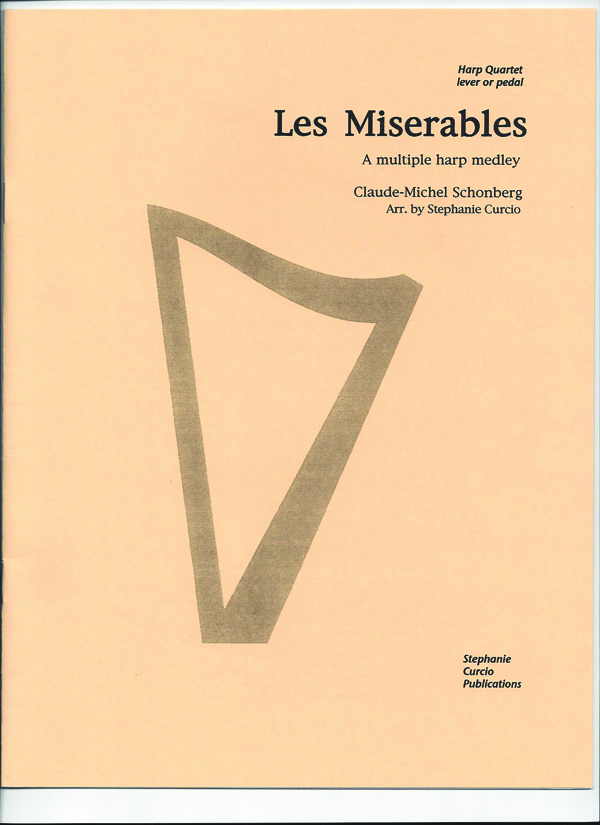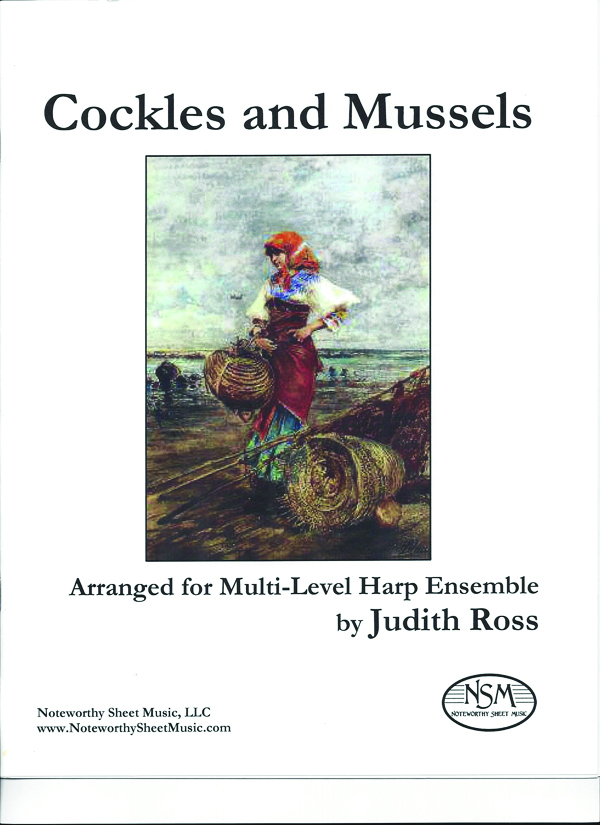There seems to be a proliferation of harp ensembles today, so it’s exciting when we get new arrangements suitable for different levels and for both pedal and lever harps.
One of our finest arrangers, Stephanie Curcio, has recently published some medleys of show tunes (Stephanie Curcio Publications). Her Fantasticks Medley for pedal harp trio is truly lovely.
Harp 1 and 2 alternate taking the melody throughout the medley. Harp 3 accompanies the other two with lots of variety and pedal changes. Harp 3 opens with an eight-measure intro on “Try to Remember” and Harp 1 brings in the melody. Both Harp 1 and 2 have harmonics in unison at measure 31 for the “follow” echoes. (If you’re not sure what that means, listen to the cast recording on YouTube.) The melody switches to Harp 2 for all of “Much More” and then back to Harp 1 for “Soon It’s Gonna Rain.” Harp 1 plays glisses to introduce the main theme. The final selection is “They Were You” with Harp 2 playing the melody to the end.
The music comes with three separate parts plus a score. It is suitable for intermediate to advanced players and all three parts are fairly equal in difficulty. No fingering is suggested (or needed), and all pedal changes are marked in the middle of the score where they won’t be missed. The pedal notation might be a little easier to read quickly if there were lines drawn indicating to keep your feet on the pedals that you will be moving back and forth such as in measures 135–138. This is a minor detail and a matter of personal preference.
The Fantasticks is dear to many harpists and Ms. Curcio has done an admirable job of putting this music in a new setting for three harps, complete with many of the “hooks” that we recall from the original production.
Ms. Curcio has also recently published a medley from Les Miserables for multiple harps. The medley includes “On My Own,” “I Dreamed a Dream,” “Lovely Ladies,” “Master of the House,” and “Do You Hear the People Sing?” It comes in two formats for intermediate level: duet for pedal harps and quartet for lever or pedal harps. The score includes both formats to enable a large ensemble, but either format can stand alone. Each of the quartet parts can be played on lever or pedal harp and the four together stand alone, but you could add any or all of the quartet parts to the duet version.
Lever harps must be tuned to E-flat for the quartet version with a couple of Ds tuned to flat in Harp 2. The lever settings can get a little tricky, with part of the harp set to E-flat and the other part set to F. All lever changes are indicated, for the most part, with diamond-shaped notes. However, in one section on Harp 1 and 3, the pedal and lever notations are combined because it was awkward to fit the diamonds on the staff.
Most lever changes are manageable. There is one unnecessary lever marking for a B-flat at the beginning of measure 45 in Harp 2, and one of the D-flat diamonds looks more like an E-flat.
Ms. Curcio has painstakingly made this arrangement work for lever harps in spite of multiple key changes. Both of these medleys are wonderful additions to ensemble repertoire.
Judith Ross has arranged some traditional Irish music for multi-level harp ensemble, published by Noteworthy Sheet Music, LLC.
“The Croppy Boy,” a pleasant ballad in A major, is the most complex. She rates Harp 1 as easy, Harp 2 as intermediate, Harp 3 as advanced, and Harp 4 as beginner. Harp 1 plays the melody, either in one hand or with both in unison. Harp 2 also plays the melody on the first two verses with some minimal left hand accompaniment. The final verse is mostly chords. Harp 3 is an eighth-note arpeggio pattern throughout. Harp 4 is mostly one note per measure in unison that is sometimes tied throughout the next measure. There are no pedal or lever changes.
Ms. Ross also arranged “Cockles and Mussels” for three harps in A major. Harp 1, rated easy, is simply the melody, either as a single note or both hands in unison, and has no lever or pedal changes. Harp 2 and 3 are nearly identical and both rated intermediate. Harp 2 doesn’t come in until letter A, but then it is exactly the same as Harp 3. They remain alike until letter C when Harp 2 has a four-measure solo. At D, both parts are again identical until letter E, the most interesting section, where they harmonize in arpeggio patterns. Harp 2 has another solo for the last four measures of the piece.
Harp 2 and 3 have a few pedal changes. This piece would have been more appealing if these two parts had alternated accompaniment patterns.
A final offering from Ms. Ross is “Love Thee, Dearest” for four harps. Only Harp 3 (advanced) has pedal changes and Harp 1 (easy), 2 (intermediate), and 4 (beginner), can be played on lever harp. It is presented in E major, but would sound more sonorous if played in E-flat, especially on lever harps tuned to E-flat. Harp 1 is the melody which is duplicated by Harp 2, with chords added below the melody on the second verse. Harp 4 is mostly one note per measure in the bass clef and Harp 3 has a running sixteenth note pattern.
All of these come with separate parts and a score and could be useful for introducing beginners to ensemble playing. •













